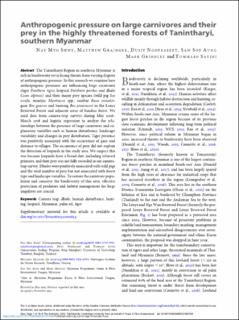| dc.contributor.author | Shwe, Nay Myo | |
| dc.contributor.author | Grainger, Matthew | |
| dc.contributor.author | Ngoprasert, Dusit | |
| dc.contributor.author | Aung, Saw Soe | |
| dc.contributor.author | Grindley, Mark | |
| dc.contributor.author | Savini, Tommaso | |
| dc.coverage.spatial | Myanmar | en_US |
| dc.date.accessioned | 2023-01-03T10:54:55Z | |
| dc.date.available | 2023-01-03T10:54:55Z | |
| dc.date.created | 2022-12-20T12:46:15Z | |
| dc.date.issued | 2022 | |
| dc.identifier.citation | Oryx. 2022, . | en_US |
| dc.identifier.issn | 0030-6053 | |
| dc.identifier.uri | https://hdl.handle.net/11250/3040580 | |
| dc.description.abstract | The Tanintharyi Region in southern Myanmar is rich in biodiversity yet is facing threats from varying degrees of anthropogenic pressure. In this research we examine how anthropogenic pressures are influencing large carnivores (tiger Panthera tigris, leopard Panthera pardus and dhole Cuon alpinus) and their major prey species (wild pig Sus scrofa, muntjac Muntiacus spp., sambar Rusa unicolor, gaur Bos gaurus and banteng Bos javanicus) in the Lenya Reserved Forest and adjacent areas of Sundaic forest. We used data from camera-trap surveys during May – March and logistic regression to analyse the relationships between the presence of large carnivores and explanatory variables such as human disturbance, landscape variability and changes in prey distribution. Tiger presence was positively associated with the occurrence of gaur and distance to villages. The occurrence of prey did not explain the detection of leopards in the study area. We suspect this was because leopards have a broad diet, including arboreal primates, and their prey was not fully recorded in our cameratrap survey. Dholes were positively associated with wild pigs and the total number of prey but not associated with forest type and landscape variables. To restore the carnivore population and conserve the biodiversity of this area, effective protection of predators and habitat management for large ungulates are crucial. Camera trap, dhole, human disturbance, hunting, leopard, Myanmar, palm oil, tiger | en_US |
| dc.language.iso | eng | en_US |
| dc.rights | Navngivelse 4.0 Internasjonal | * |
| dc.rights.uri | http://creativecommons.org/licenses/by/4.0/deed.no | * |
| dc.subject | Camera trap | en_US |
| dc.subject | dhole | en_US |
| dc.subject | human distrbance | en_US |
| dc.subject | hunting | en_US |
| dc.subject | leopard | en_US |
| dc.subject | Myanmar | en_US |
| dc.subject | palm oil | en_US |
| dc.subject | tiger | en_US |
| dc.title | Anthropogenic pressure on large carnivores and their prey in the highly threatened forests of Tanintharyi, southern Myanmar | en_US |
| dc.title.alternative | Anthropogenic pressure on large carnivores and their prey in the highly threatened forests of Tanintharyi, southern Myanmar | en_US |
| dc.type | Peer reviewed | en_US |
| dc.type | Journal article | en_US |
| dc.description.version | publishedVersion | en_US |
| dc.rights.holder | © 2022 The Authors | en_US |
| dc.subject.nsi | VDP::Zoologiske og botaniske fag: 480 | en_US |
| dc.subject.nsi | VDP::Zoology and botany: 480 | en_US |
| dc.source.pagenumber | 10 | en_US |
| dc.source.journal | Oryx | en_US |
| dc.identifier.doi | 10.1017/S0030605321001654 | |
| dc.identifier.cristin | 2095674 | |
| dc.relation.project | Andre: Helmsley Charitable Trust | en_US |
| dc.relation.project | Andre: EU | en_US |
| dc.relation.project | Andre: Integrated Tiger Habitat Conservation Project (ITHCP1338) | en_US |
| cristin.ispublished | true | |
| cristin.fulltext | original | |
| cristin.qualitycode | 1 | |

